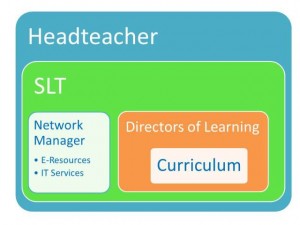This post started out as ‘Important and Urgent then Do It Part 2.’ It was reviewing the decision making process within the ICT Department and IT Services. However, as it was neither Important nor Urgent, time passed and a lot of revisions and thinking has gone into the post. In its final form, it is now more clearly focused on the ICT / IT conundrum.
Two and half years into the post, I am more certain than ever that there is a need for schools to separate ICT from IT (I see this more frequently in the post 16 sector). IMHO ICT teachers should be practitioners in the classroom and not cajoled into being pseudo Network Managers, VLE Administrators / Website Designers. Are Design Technology staff expected to support the Premise Manager or English staff expected to support Librarians? If not for professional parity but for logistical reasons. IT Services are busiest when schools are quietest, is it fair to expect ICT teaching staff to oversee IT Services during holiday periods? Where else could this expectation made? Finally, in Sept we will have a HOD for ICT, a Network Manager leading a IT Services team within which, an E-resources Manager working along the ICT/IT boarder.
IT Services
Without question, decision making and prioritising IT Services development is more difficult because IT / technology development is rarely defined by a single variable or factor. Some are very obvious, others are less so, but all impact upon the decision making process and final outcome. Although it was never urgent, it was important– as noted we have gradually separated ICT from IT. We moved the IT support office and we rebranded the team ‘IT Services’ and defined the roles within.
Why was this necessary? I often read / hear about the fraught Network Manager – Headteacher relationships. Headteachers don’t speak servers, SANs and switches and only a few outstanding bi-lingual Network Managers speak ‘Teaching and Learning.’ It is easy to see why ICT staff get drawn into the strategic discussion as intermediaries or translator and the for reasons outlined above. With the exception of two schools that I have personally visited, schools / colleges that showed most IT maturity and integration with the curriculum have all demonstrated the following qualities.
- Leadership backing (not merely investment)
- IT and ICT as independent
- Use of both OSS and Propriety solutions in a best fit model
- Lead IT development within their schools as CPD
This post emphasises the second point quiet loudly. In discussion with our Network Manager this is necessary because from his viewpoint, all department are his clients. The ICT Department maybe their largest but by no mean the most important. In fact, prioritising ICT only serves to weaken the relationship with the remaining Departments, leaving them frustrated and with a sense of inequality. IT and ICT budgets naturally get interwined or confused, resources get shared when they should have been restricted or restricted when they should have been shared. In lead meetings ICT staff get challenged when whole school IT projects fail to deliver and know one gets true credit when they are successful. After all, its supposed to just work.
Headteachers / SLT rarely comprehend the complex interactions occurring with IT Services (nor should/do they have the time to). Sadly, rarely does the rock face does reflect the health of the network behind it. Capacity to grow and continuity of service is often neglected over current financial constraints leaving the Network Manager exasperated.
ICT is not IT and it may have taken me 12 months to recognise it, it has taken me a further 18 moths to make the separation. Now, we will see if the new structure improves the IT with the school and allows the ICT Head of Department the time to develop the ICT curriculum in earnest.
For the record I shared this post with Tony Sheppard @GrumbleDook Northamptonshire County Council’s ‘Harnessing Technologies Manager,’ for his professional view, in an effort to balance the slight bias or educational focus. Any comments he offers I will add here some.

